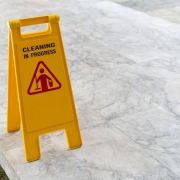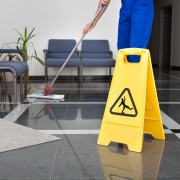How to Implement Workplace Safety Programs
Protecting your employees and your business’s finances is likely at the forefront of your workplace priorities. Despite this, it can be hard to know where to start with your workplace safety programs.
Safety doesn’t need to be made overly complicated though. By following simple steps to keep your employees safe that your business can then expand upon, you can get started with creating optimal, structured workplace safety programs that will protect your employees and your bottom line.
Here are our suggestions, broken down into a step-by-step system, to help you more mindfully approach your workplace safety programs.
How to Develop Workplace Safety Programs
Step 1: Identify Workplace Hazards
When looking for hazards in your business, you are essentially looking for potential events that could cause harm to your employees. While you can’t always fully prevent these hazards from happening, you can take precautions to reduce your risk.
But how do you find them to begin with? A good place to start is to talk to your current employees or release a company survey for employees to anonymously fill out. Because they are constantly immersed in the everyday occurrences of your business, they have likely developed concerns over particular areas of the facility – whether it’s common areas with spills, changes in floor traction, or even just sanitary problems such as a low stock of toilet paper and hand soap.
When looking to identify hazards, you are essentially looking at hazards caused by the job activity (the actual tasks employees do as part of their job – such as working with heavy machinery or around a hot stove), workplace and environmental circumstances (such as slippery floors or dust accumulation that can be dangerous around your workplace’s machinery), and emergency events (hazards that weren’t prevented or were accidental).
If this is your first time evaluating the safety of your workplace, though, we recommend also having a professional come in to inspect your business, as he or she will be familiar with common workplace hazards that neither you nor your employees may have thought of.
Step 2: Commit to Workplace Safety
Keep in mind during your efforts that workplace safety isn’t a one-time task to tick off your to-do list. It’s integral that you put measures in place so that any time an employee has a concern about health or safety hazards, that they have a way to communicate such concerns with you. This could be following up with each person individually, having a form they can fill out anonymously anytime they have a concern, or sending out safety surveys to employees every quarter.
Encouraging your employees to stay involved throughout the entire process will help them feel safe coming to you with concerns, and you’ll more frequently and easily be able to identify workplace safety hazards and prevent them.
It’s also important to remove any bias regarding risk assessment. If an employee reports a problem or concern, or there is an accident on the job, it is your responsibility to address the issue and find a future solution to prevent it from happening again. Even if you want to place the blame on the employee, consider if there are any extra things that could have been done differently to prevent the problem. For example, maybe in the case of a slip-and-fall accident, the employee should have worn high-traction shoes according to the requirement you list in your employee handbook. Despite this, you still could have provided floor mats in the case that the employee’s shoes weren’t as protective as the individual thought they were.
Develop an environment in your workplace where reporting problems and finding solutions can be productive and non-combative. As safety risks are constantly being uncovered, make sure you are taking constant action to prevent the impending hazards.
Step 3: Develop Workplace Safety Materials to Educate Employees
There’s two major aspects of workplace safety programs – your effort as an employer to keep your employees safe, and your employees’ own knowledge of safety practices. That’s why it’s not just about detailing what employees are responsible for in your handbook, but you should also formally train them so they know what to do to prevent accidents and what to do in the case of an injury either to themselves or their coworkers.
This training is something employees should undergo at the start of the job, and training should also be conducted from time to time as a refresher for employees or as updates are made to the program. Depending on each employees’ duties, OSHA has set up requirements and standards for you to follow regarding employee training and hiring. As you are setting up your written training program and processes, as well as when you are looking to hire new individuals, check your specific OSHA requirements.
Your processes should include job description requirements that clearly detail the safety risks involved in the job and the requirements to be able to safely do the job, information on reporting hazards and injuries, and, of course, training on how to safely handle work tasks, working in your environment, and what to do in the case of an emergency.
Implementing your workplace safety program may take some research, and it isn’t a project that starts now and ends on a specific date. But if you plan to evaluate your program every year, and you get started with the right protective supplies, you’ll be on your way to safer working.
At Garden State Mat Rental, we offer a variety of commercial mat rentals and facility services to not only help improve your business’ cleanliness but to protect your employees from slip-and-fall accidents and from potentially getting sick from not having enough hygienic supplies in stock.
To request your free quote, simply contact us today at 800-486-1581.











